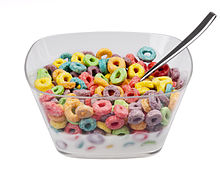Ultra-processed food


An ultra-processed food (UPF) is an industrially formulated edible substance derived from natural food or synthesized from other organic compounds.[1][2] The resulting products are designed to be highly profitable, convenient, and hyperpalatable, often through food additives such as preservatives, colourings, and flavourings.[3] UPFs have often undergone processes such as moulding/extruding, hydrogenation or frying.[4]
Ultra-processed foods first became ubiquitous in the 1980s,[5] though the term "ultra-processed food" was brought to promience by a 2009 paper by Brazilian researchers as part of their new Nova classification system.[6] The state of research into ultra-processed foods and their effects is evolving rapidly as of 2024.[7][4]
Epidemiological data suggest that consumption of ultra-processed foods is associated with higher risks of many diseases, including obesity, type 2 diabetes, cardiovascular diseases, asthma, specific cancers, and all-cause mortality.[8] Food addiction may also be associated with consumption of ultra-processed foods.[9]
Ultra-processed foods make up a significant proportion of the diet of developed countries, varying from 10% in Romania to over 50% in the United Kingdom and the United States.[4]
Some authors have criticised the concept of "ultra-processed foods" as poorly defined, and the Nova classification system as too focused on the type rather than the amount of food consumed.[10]
Definitions
Concerns around food processing have existed since at least the Industrial Revolution.[11] Many critics identified 'processed food' as problematic, and movements such as raw foodism attempted to eschew food processing entirely, but since even basic cookery results in processed food, this concept failed in itself to influence public policy surrounding the epidemiology of obesity.[citation needed]
Michael Pollan's influential book The Omnivore's Dilemma referred to highly processed industrial food as 'edible food-like substances'.[12] Carlos Augusto Monteiro cited Pollan as an influence in coining the term 'ultra-processed food' in a 2009 commentary.[13] Monteiro's team developed the Nova classification for grouping unprocessed and processed foods beginning in 2010, whose definition of ultra-processing has become most widely accepted and has gradually become more refined through successive publications.[14] The identification of ultra-processed foods, as well as the category itself, is a subject of debate among nutrition and public health scientists, and other definitions have been proposed.[15]
A survey of systems for classifying levels of food processing in 2021 identified four 'defining themes': "1. Extent of change (from natural state); 2. Nature of change (properties, adding ingredients); 3. Place of processing (where/by whom); 4. Purpose of processing (why, essential/cosmetic)."[16]
Monteiro's 2009 commentary
Carlos Monteiro, working with a team of researchers at the University of São Paulo, first published the concept of ultra-processed foods in a 2009 invited commentary for Public Health Nutrition:
Ultra-processed foods are basically confections of group 2 ingredients [substances extracted from whole foods], typically combined with sophisticated use of additives, to make them edible, palatable, and habit-forming. They have no real resemblance to group 1 foods [minimally processed foods], although they may be shaped, labelled and marketed so as to seem wholesome and 'fresh'. Unlike the ingredients included in group 2, ultra-processed foods are typically not consumed with or as part of minimally processed foods, dishes and meals. On the contrary, they are designed to be ready-to-eat (sometimes with addition of liquid such as milk) or ready-to-heat, and are often consumed alone or in combination (such as savoury snacks with soft drinks, bread with burgers).[13]
This definition is as much social as one based on specific ingredients, which makes the understanding of ultra-processed foods highly intuitive, even among untrained consumers.[17][18] A letter responding to Monteiro's 2009 commentary suggested that the definition 'lacks precision', since it lacks the measurable definitions of traditional food science.[19] Because of this, researchers disagree whether the definition can form a valid basis for scientific control.[20] Researchers have developed a quantitative definition for hyperpalatable food, but not for ultra-processed food.[21]
Nova classification

Monteiro's team subsequently presented ultra-processed foods as a group in the Nova food classification system.[6] The system focuses on food processing rather than foods types or nutrients. Nova categorizes foods into four groups:[3] unprocessed or minimally processed foods, processed culinary ingredients, processed foods, and ultra-processed foods.
Nova is an open classification that refines its definitions gradually through new scientific publications rather than through a central advisory board.[14] The most recent overview of Nova published with Monteiro defines ultra-processed food as follows:
Industrially manufactured food products made up of several ingredients (formulations) including sugar, oils, fats and salt (generally in combination and in higher amounts than in processed foods) and food substances of no or rare culinary use (such as high-fructose corn syrup, hydrogenated oils, modified starches and protein isolates). Group 1 foods are absent or represent a small proportion of the ingredients in the formulation. Processes enabling the manufacture of ultra-processed foods include industrial techniques such as extrusion, moulding and pre-frying; application of additives including those whose function is to make the final product palatable or hyperpalatable such as flavours, colourants, non-sugar sweeteners and emulsifiers; and sophisticated packaging, usually with synthetic materials. Processes and ingredients here are designed to create highly profitable (low-cost ingredients, long shelf-life, emphatic branding), convenient (ready-to-(h)eat or to drink), tasteful alternatives to all other Nova food groups and to freshly prepared dishes and meals. Ultra-processed foods are operationally distinguishable from processed foods by the presence of food substances of no culinary use (varieties of sugars such as fructose, high-fructose corn syrup, 'fruit juice concentrates', invert sugar, maltodextrin, dextrose and lactose; modified starches; modified oils such as hydrogenated or interesterified oils; and protein sources such as hydrolysed proteins, soya protein isolate, gluten, casein, whey protein and 'mechanically separated meat') or of additives with cosmetic functions (flavours, flavour enhancers, colours, emulsifiers, emulsifying salts, sweeteners, thickeners and anti-foaming, bulking, carbonating, foaming, gelling and glazing agents) in their list of ingredients.[22]
The Nova definition of ultra-processed food does not comment on the nutritional content of food and is not intended to be used for nutrient profiling.[23]
International Agency for Research on Cancer (IARC)
The International Agency for Research on Cancer, an intergovernmental agency that forms part of the World Health Organization, classifies foods by their degree of processing. This system breaks food into 'non-processed', 'moderately processed', and 'highly processed' food.[24] The system does not take into account the nature or purpose of changes.[25]
Siga Index
The Siga Index is a classification system for processed foods developed in France in 2018.[26] It is based on both the degree of processing and the nutritional quality of foods, using a holistic and reductionist approach.[27]
The Siga Index assigns a score from 1 to 100 to each food product, where higher scores indicate higher nutritional quality and lower processing. The Siga Index also defines ultra-processed foods (UPFs) as those with a score below 40, which are considered to have low nutritional value and high levels of additives, preservatives, and artificial ingredients.[28]
International Food Information Council (IFIC)
The International Food Information Council defines five levels of food processing:[29][30] minimally processed, foods processed for preservation, mixtures of combined ingredients, ready-to-eat processed foods, and prepared foods/meals.
NUPENS
The Center for Epidemiological Research in Nutrition and Health at the University of São Paulo has proposed a variant on the Nova classification consisting of:[31] unprocessed, minimally, or moderately processed foods; processed foods; and ultra-processed foods.
Economics
The high amount of processing lends ultra-processed food to be subject to different economic constraints compared to natural food.
Profitability

Ultra-processed foods often use less expensive ingredients, allowing ultra-processed food to be priced lower.[32] Furthermore, ultra-processed foods are more consistently available in stores.[33][34] This is enabled by food industry practices, including establishing global production networks, establishing large-scale and local distribution networks, and aggressive marketing.[35]
Global production networks of companies creating ultra-processed food are supported by high brand awareness, aggressive globalization tactics, and the purchasing of local companies selling similar products.[35]
Companies selling ultra-processed food frequently target youth consumers and middle income countries.[36][37] Many of these companies use big data to choose which consumers to market to.[38]
Furthermore, the ultra-processed food industry uses indirect and direct lobbying in large countries to influence local food policy.[39][40]
Affordability for consumers

They often have an extended shelf life, an important consideration for lower income consumers without reliable access to refrigeration.
Among other reasons for the popularity of ultra-processed foods are the inexpensive cost of their main ingredients. The price of ultra-processed food fluctuated less than unprocessed food over a twelve year period.[32]
Health effects
The effect of ultra-processed foods on health has mainly been investigated using nutritional epidemiology and so far there has been no randomized controlled trial to investigate the effect of these foods on any health outcome other than weight gain. These studies have shown an overall increased risk for disease,[8][41] although studies separating different types of ultra-processed food have found adverse affects mainly for only some sub-groups such as soft drinks.[42] Overall, there is an association between certain poor health outcomes – including poor cardiometabolic and mental health, and reduced life expectancy – and consumption of UPF.[7]
One possible explanation for the adverse effect on health are the high amounts of sugar, fat and salt in these foods, although that does not apply to all ultra-processed foods. Other potential explanations are the presence of contaminants, certain food additives, and the high heat treatment of these foods.[43] There is currently however no scientific consensus.[44]
Environmental impact
Beyond health implications, the production of ultra-processed foods also has significant environmental impacts.[45] These foods require extensive processing and packaging, resulting in higher energy consumption and waste production compared to minimally processed foods. Moreover, the globalized supply chains for the ingredients of ultra-processed foods contribute to greenhouse gas emissions.[46]
Regulation and policy
Given the health and environmental impacts of ultra-processed foods, there have been calls for better regulation and policy surrounding these products. These measures face significant challenges, including industry opposition and the global nature of food supply chains. Future policy efforts may require a combination of regulation, education, and incentives to promote healthier, more sustainable food choices.
Four Latin American countries—Brazil,[47] Uruguay,[48] Peru,[49] and Ecuador[50]—have so far published national official dietary guidelines that recommend avoiding ultra-processed foods. Chile requires warning labels on some ultra-processed foods and taxes sugar-sweetened beverages.[51] A report on obesity published by the World Bank in 2020 mentions ultra-processed foods as a potential contributor.[52]
In 2022, the Scientific Advisory Committee on Nutrition (SACN) reviewed scientific literature to consider whether the British government should adopt a position on ultra-processed food and recommended further research, scheduling a review on its position for June 2024.[44]
Criticism
Following the publication of the Nova classification, some researchers questioned whether food processing should itself be considered a factor in nutrient intake, especially in a prominent 2017 criticism written by researchers, one of which was funded by Nestlé and the Kerry Group.[53] UPFs are imprecisely defined and it is unclear how any adverse effects on health may come about.[54]
In 2022, Carlos Monteiro and Arne Astrup argued for and against the Nova classification in a series of three articles written in the style of an Oxford debate. Montiero 'yes' argument states that the effects of ultra-processed food are demonstrated by representative dietary surveys and long-term cohort studies; that consuming ultra-processed food is associated with negative health outcomes; and that the associations are supported by discussions of specific mechanisms.[55] Astrup's 'no' argument states that the Nova definition of ultra-processed foods is ambiguous and inherently leads to misclassification of foods; that evidence is lacking for effects that aren't already accounted for by known factors such as nutrient composition; that existing evidence is limited to observational studies rather than being supported by randomized controlled trials; and that some ultra-processing techniques are valuable in achieving the transition to sustainable food production.[56] The two researchers nonetheless agreed that food processing significantly affects diet quality and health outcomes; that most types of food processing are harmless or beneficial, with a minority being harmful; that some characteristics of food processing are useful for food classification systems; and that further study is required to understand the effect of food processing on human health.[57]
See also












